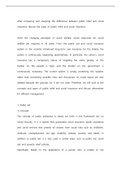Other
Learning Aim A :Understand the structure and function of nucleic acids in order to describe gene expression and the process of protein synthesis
- Course
- Institution
This assignment is only the merit and distinction part and both merit and distinction were met.
[Show more]












